
The molecular composition of the blood provides information regarding one’s state of health, and may be compared to an individual fingerprint. In principle, changes in the constituents of blood can serve as early signs of disease. However, before chemical fingerprints can be utilized for diagnostic purposes, the stability of the molecular patterns in healthy persons over time must be firmly established. Researchers under the direction of Dr. Mihaela Žigman, Head of the Broadband Infrared Diagnostics (BIRD) group in the Department of Laser Physics led by Prof. Ferenc Krausz at LMU Munich and the Max Planck Institute of Quantum Optics (MPQ), in collaboration with Prof. Dr. Nadia Harbeck at the LMU Medical Center, have now successfully accomplished this task. With the aid of a method known as Fourier-transform infrared spectroscopy (FTIR), the team has shown that the molecular composition of blood samples obtained from a cohort of healthy donors remains stable over a period of several months, and confirmed that each of the resulting spectra could be clearly assigned to an individual person.
Rapid diagnosis of human diseases is a longstanding problem in medicine. As diseases often alter molecular make-up of circulating body fluids, obtaining a snapshot of their molecular composition would be invaluable in detecting a multitude of diseased states, and the types and concentrations of the many molecules found in the bloodstream can provide vital information on a person’s health. The real challenge, however, comes when one tries to determine exact composition of body fluids, given that the concentrations of informative molecules are often extremely low. The interdisciplinary BIRD team led by Dr. Mihaela Žigman in Prof. Dr. Ferenc Krausz’s department at LMU, in collaboration with Prof. Dr. Nadia Harbeck at the LMU Medical Center, has now investigated the stability of the chemical make-up of blood samples over days, weeks and even months.
Based on Fourier-transform infrared measurements (FTIR), the researchers analyzed the molecular fingerprints of serum and plasma samples obtained from 31 healthy individuals over the clinically relevant period of 6 months. The study demonstrated that the infrared molecular fingerprint of each individual donor in fact remained stable over periods ranging from a few days to weeks and months, and each temporal profile could be readily attributed to the participant concerned.
“This newly revealed temporal stability of blood-based infrared fingerprints provides a basis for future applications of minimally invasive infrared spectroscopy as a reliable method for the future of health monitoring,” says Mihaela Žigman, leader of the research group.
Standard Fourier-transform infrared spectroscopy, which uses conventional light sources, could soon be replaced by chemical analyzes based on infrared lasers. Given the much higher intensity of laser light, the latter method should be more sensitive and precise, and should therefore yield more detailed and informative characterizations of the molecular constituents of blood. The physicists in the attoworld team, led by Prof. Ferenc Krausz, are now working on the laser technologies necessary to achieve this aim. Exposure to intense infrared light causes molecules to vibrate and emit light at specific frequencies, which depend on the chemical structures of the molecules within the sample. Analysis of the components of the resulting spectrum of electromagnetic oscillations enables researchers to assign them to the many types of molecules present in body fluids. As Prof. Krausz and colleagues reported last year, the new method allows minuscule amounts of different classes of molecules to be spectroscopically detected (Nature, 2. January 2020).
Source: Read Full Article